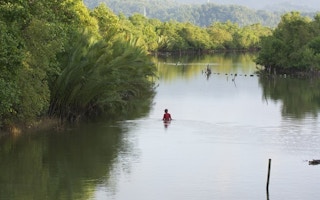Rising temperatures will not themselves spell disaster for the world’s rainforests. It is the droughts and unpredictable rainfall patterns, which climate change is already worsening, that will settle the forests’ fate before the century ends, according to a new book.
Claude Martin, who has worked in tropical rainforest conservation since the 1970s, is author of On the Edge, commissioned by the Club of Rome, which published the seminal Limits to Growth report in 1972. Since then, nearly 50 per cent of the world’s forest cover has disappeared.
Martin, a former director-general of WWF International, recognises that there are many drivers of forest damage and destruction − including the pressures of the global economy for animal feed and food for humans, and the worldwide demand for biofuels.
Essential ecosystem
Acknowledging the progress made in science and conservation, he reminds his readers that the forests are not just huge repositories of biodiversity, but an essential ecosystem providing everyone on the planet with fresh water, clean air and climate regulation.
“
The current rate of greenhouse gas emissions, the lethargy of governments and the impotence of the intergovernmental system make it very unlikely that average global warming will be kept below 2°C.
Claude Martin, former director-general of WWF International and author of On the Edge
Evaluating the impact of climate change on rainforests means focusing on the length of dry seasons and water stress, rather than temperature, Martin writes.
The likeliest cause of forest collapse and severe risks of reaching a tipping point is not temperature rise, but the change from the dependable rainfall patterns of the past, and the probability of increasing droughts and forest fires.
He sees a likelihood of drought and fires increasing − not least in the Amazon − because of the way in which climate change is fuelling El Niño and La Niña, the twin periodic temperature disruptions that occur every few years in the eastern Pacific Ocean.
Known together as the El Niño-Southern Oscillation (ENSO), their impacts spread for thousands of miles.
Martin is one of those scientists who are convinced that climate change will intensify ENSOs. As global warming effects become stronger, ENSO events become more frequent, rainfall drops further because of forest loss and fragmentation, and droughts are likely to become more common and more severe. And so the vicious circle becomes a constant downward spiral.
“When the 20th century’s strongest ENSO occurred in 1997/98,” Martin writes, “it was considered to be an unusual phenomenon… . [It] caused severe drought in Amazonia, Southeast Asia and Mexico, and had massive effects on the net primary productivity of forests, thus their capacity of carbon storage as well as forest fires.”
After another severe drought in 2001, following another ENSO event, about a third of the Amazon forests stored significantly less carbon and became vulnerable to fire. Two more droughts followed soon after, in 2005 and 2010. The first was estimated to be a once-in-a-century occurrence.
Fastest warming
Martin’s concerns are not confined to Amazonia. He cites modelling by the Intergovernmental Panel on Climate Change, which shows that Africa is expected to warm by 3-4°C by the end of the century − the fastest warming since the end of the last ice age around 11,500 years ago. This would expose the great Congo Basin forest to the risk of severe damage.
Globally, Martin is not hopeful. “The current rate of greenhouse gas emissions, the lethargy of governments and the impotence of the intergovernmental system make it very unlikely that average global warming will be kept below 2°C,” he says.
Under a mid-range emissions scenario, atmospheric CO2 concentrations are likely to rise by the end of the century to levels not seen in the last 50 million years. But he thinks the forest crisis will be developing uncontrollably some decades before then.
He predicts: “The decisive period for the long-term future of the rainforests … will be the second half of the century, when global warming is likely to exceed 2°C above the pre-industrial global average.
“It will be too late then to avoid a dangerous tipping point of self-reinforcing climate change.”
On the Edge − The State and Fate of the World’s Tropical Rainforests. A Report to the Club of Rome, by Claude Martin (Greystone Books, £20/US$32.95).










